Do you have a favorite color of M&M, or a favorite type of M&M? Personally, I’m partial to orange M&Ms and mini M&Ms. You might think that orange M&Ms taste the same as all the other colors, and minis taste the same as regular-size, but you’d only be half right! Although you might expect both color and size to be irrelevant in the candy’s taste, I have noticed over the years that some people seem to be genuinely more excited about mini M&Ms. I started to wonder if there might really be a difference, and inevitably this also got me thinking about nanotechnology.
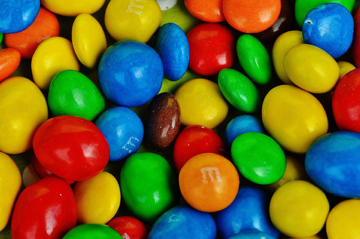
To find out if this preference for M&M minis was widespread, I took to Twitter. I created Twitter polls to ask three questions:
- Do M&Ms and Mini M&Ms taste different?
- Which tastes better?
- Which tastes sweeter?
The results are shown in the graph below. Overall, it seems that folks agree that M&Ms and mini M&Ms taste different, that mini M&Ms taste better, and that mini M&Ms even taste sweeter.

Now that I knew my preference towards mini M&Ms went beyond a personal idiosyncrasy, I wanted to understand why. M&Ms and mini M&Ms are, after all, made of the exact same components – chocolate center and candy shell. They’re just a different size. While a change in properties with different sizes might seem strange at first, it is probably very familiar to readers of this blog as a fundamental principle of nanotechnology! We’ve written a lot about how, for example, if you took the gold from a gold ring and shrunk it to the nanoscale, it would change color and when you size down battery electrode materials to the nanoscale you get a change in battery efficiency. When you shrink down M&Ms into mini M&Ms, you get a sweeter, more enjoyable confection (at least as far as about ~70% of my poll participants are concerned).
But was it really that straightforward?
To fully understand this effect, I had to answer a few more questions:
- Do M&Ms and mini M&Ms have meaningfully different ratios of chocolate to candy shell?
- Do M&Ms and mini M&Ms have meaningfully different nutritional values?
- Do M&Ms and mini M&Ms have meaningfully different surface area to volume ratios?
Question 1: Candy/Shell Ratios
My experiment started at the grocery store. I picked up a bag of standard sized M&Ms and a tube of mini M&Ms. At home, I cut 10 standard M&Ms in half with a sharp blade and discarded (ate!) one half of each. I then cut 10 mini M&Ms in half and discarded (ate, again!) one half of each. This left me with 10 individual M&M samples of each type. I placed my experimental halves in a shallow dish of black sand and set a ruler in the picture frame as well. Here’s a picture of all my M&Ms and the ruler for scale.
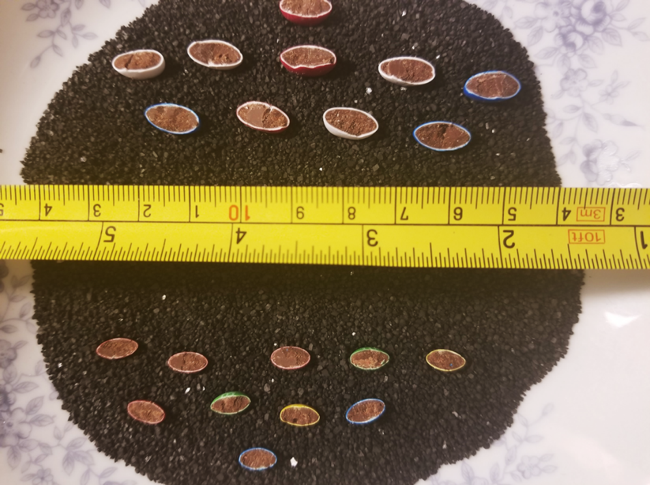
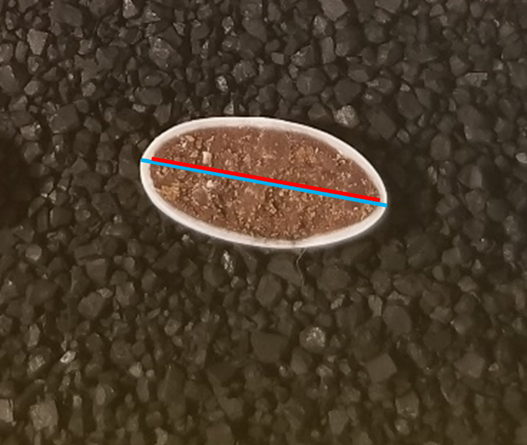
I then measured the length and width (aand caxes shown on Figure 5) of each M&M and mini M&M using a program called ImageJ. (Normally, I use ImageJ to measure actual nanoparticles from microscopy images!) I measured two parameters for each axis — total distance and “chocolate” distance. (The candy shell was too narrow to measure easily, but we’ll deal with that in a minute.) So now I had four measurements for each sample as you can see in the mini M&M table below:

Now, it’s time for a little bit of math! I was very interested in the chocolate to candy shell ratio because I thought that it might account for some difference in taste between the two sizes of M&M. To figure this out, I needed the volumes of the shell and the chocolate. The total volume and the chocolate volume were pretty easy to figure out based on my measurements above. The squashed-sphere shape of an M&M is called an ellipsoid. I calculated total volume (V) according to the following equation:
V = (4/3) π abc
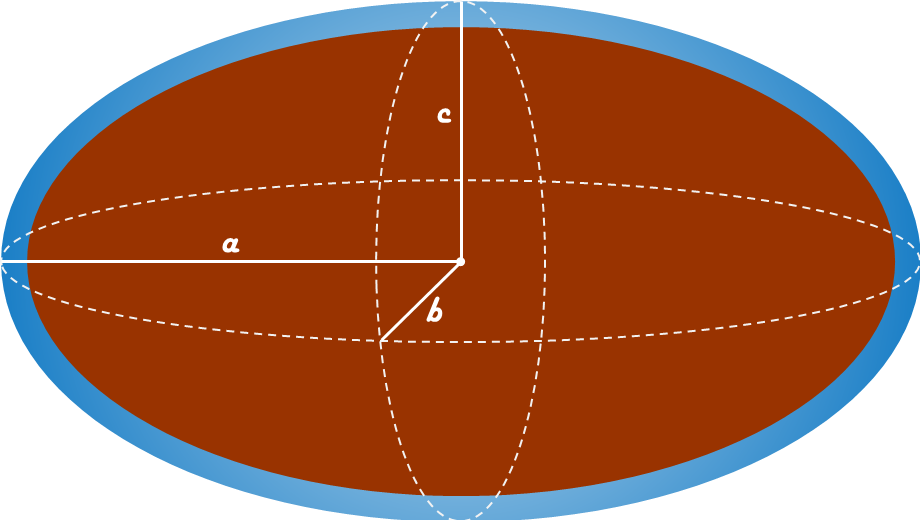
My length and width measurements correspond to a and c in the drawing above, and because M&Ms are circular when looking at the face with the “M” label, we can assume that b is the same as a (Figure 5).
Now all I needed was the candy shell volume to calculate my ratios. Since I had the total and the chocolate volumes, I was able to figure out the shell volume by subtracting the chocolate from the total:
(total volume) – (chocolate volume) = (candy shell volume)
From this, I was able to calculate what percent of each type of M&M was chocolate versus candy shell. Results are shown in Table 2.
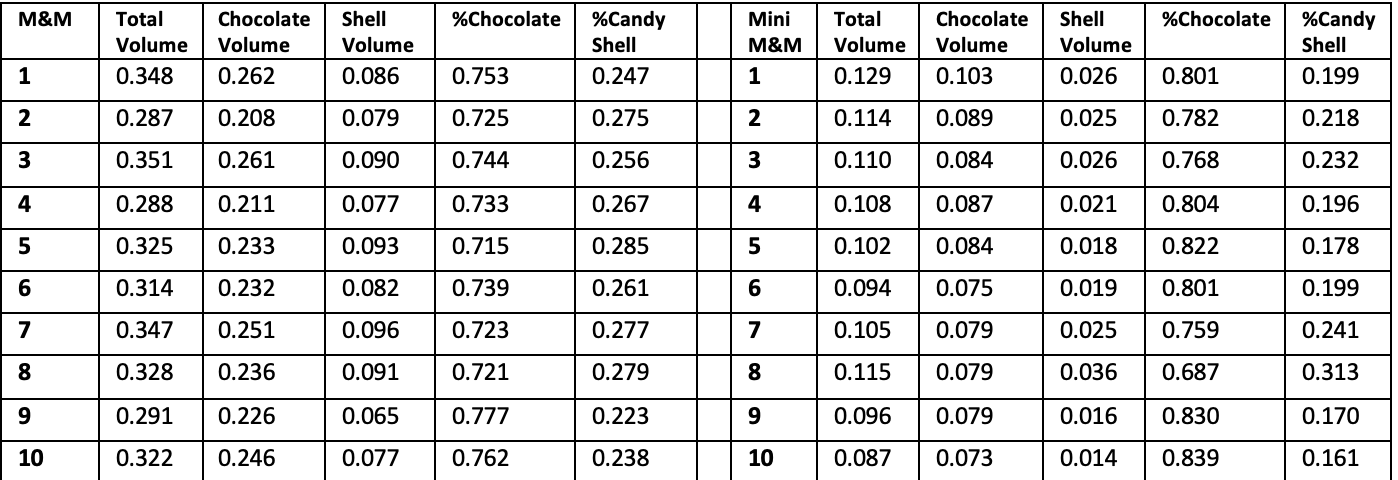
On average, Mini M&Ms and standard M&Ms are approximately 79% and 74% chocolate, respectively. However, as you can see in Table 2, there is some deviation in this measurement. Therefore, I don’t think that minis having a slightly higher percentage of chocolate is the key to the different taste!
Question 2: Nutritional components
I also investigated nutritional facts available on the official M&Ms nutrition page. Mini M&Ms and standard M&Ms have approximately the same ingredients, same sugar percentage by mass, and roughly the same caloric value. This tells me there isn’t anything strictly nutritionally different about them to account for the observed sweeter taste of mini M&Ms.
Question 3: Surface area/volume ratios
Finally, I used the same data from my volume measurements to calculate the surface area of each type of M&M. The equation for surface area (S) is:
S = 4 π [ ((ab)1.6+ (ac)1.6 + (bc)1.6)/3 ]1/1.6
Now I was able to calculate the surface area to volume ratio (Table 3). The surface area/volume ratio is well known in nanotechnology and is often used to explain many of the unique properties of nanoparticles.
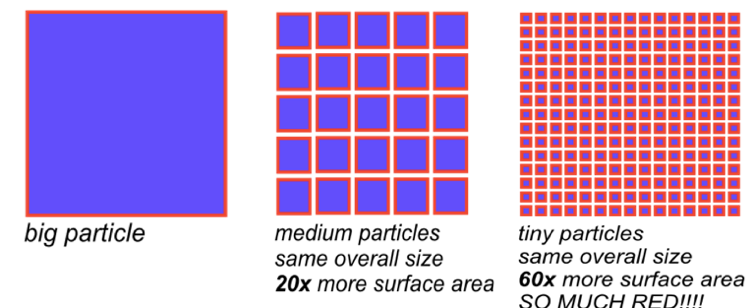
Standard M&Ms have a surface area/volume ratio of 7.8 and mini M&Ms have a surface area/volume ratio of 11.1. This increase in surface area/volume ratio is likely why mini M&Ms seem so much sweeter! For each equal amount of candy, your saliva is able to make contact with more candy surface, dissolve more sugar, and deliver more “sweet” taste to your tastebuds!

Another way to think about this is to calculate that you would need 3 mini M&Ms to get the same volume of candy as one standard M&M. These three mini M&Ms would have a total surface area of 3.55 cm2, but the standard M&M of equivalent volume would only have a surface area of 2.49 cm2. That’s over 1 cm2extra of surface area for the same volume of chocolate!
Since we all need excuses to eat sweet treats, you could test this property with many other foods. For example, try tasting a sugar cube (small surface area to volume ratio) versus loose sugar (big surface area to volume ratio), or chocolate chips compared to mini chocolate chips. While there are many different options, M&Ms and mini M&Ms are a prime example of a tenet of nanotechnology: shrinking something down changes its properties!
More Sustainable Nano blog posts on surface area, volume, & food
- How to Avoid Bitter Coffee and Why it Exists in the First Place – a scientific look at brewing
- What Does Nanotechnology Have to Do with Chocolate?
- Can gold melt at room temperature? Melting temperature depression!
- Why Does Old Ice Cream Get Crunchy?
More M&M Math
Total volume of regular M&M: 0.320 cm3
Total volume of Mini M&M: 0.106 cm3
Total surface area of regular M&M: 2.49 cm2
Total surface area of mini M&M: 1.18 cm2

Might have been nice to consider the fact that your original survey was purely suggestive in its results (after all if you are educating us about measurement you might as well touch upon sample size and tests of significance).